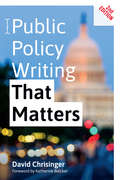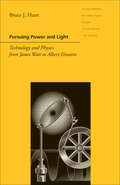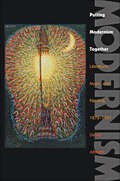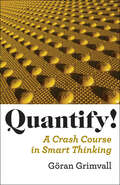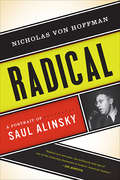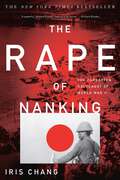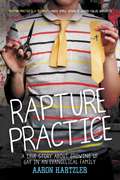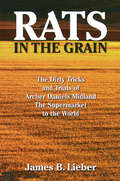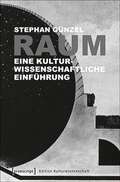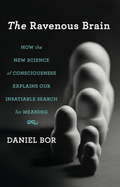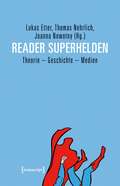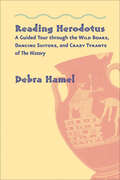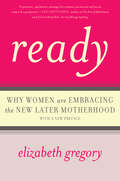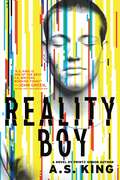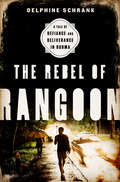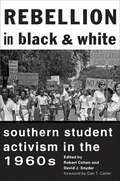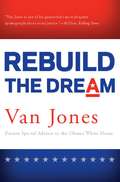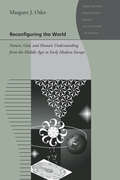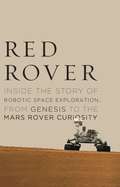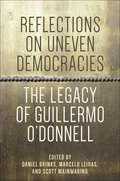- Table View
- List View
Public Policy Writing That Matters
by David ChrisingerA thoroughly updated and expanded guide to honing your public policy writing skills—and making a significant impact on the world.Professionals across a variety of disciplines need to write about public policy in a manner that inspires action and genuine change. You may have amazing ideas about how to improve the world, but if you aren't able to communicate these ideas well, they simply won't become a reality. In Public Policy Writing That Matters, communications expert David Chrisinger, who directs the Harris Writing Program at the University of Chicago and worked in the US Government Accountability Office for a decade, argues that public policy writing is most persuasive when it tells clear, concrete stories about people doing things. Combining helpful hints and cautionary tales with writing exercises and excerpts from sample policy analysis, Chrisinger teaches readers to craft concise, story-driven pieces that exceed the stylistic requirements and limitations of traditional policy writing.Aimed at helping students and professionals overcome their default impulses to merely "explain," this book reveals proven tips—tested in the real world and in the classroom—for writing sophisticated policy analysis that is also easy to understand. For anyone interested in planning, organizing, developing, writing, and revising accessible public policy, Chrisinger offers a step-by-step guide that covers everything from the most effective use of data visualization to the best ways to write a sentence, from the ideal moment for adding a compelling anecdote to advice on using facts to strengthen an argument. This second edition addresses the current political climate and touches on policy changes that have occurred since the book was originally published. A vital tool for any policy writer or analyst, Public Policy Writing That Matters is a book for everyone passionate about using writing to effect real and lasting change.
Public Policy Writing That Matters
by David ChrisingerA thoroughly updated and expanded guide to honing your public policy writing skills—and making a significant impact on the world.Professionals across a variety of disciplines need to write about public policy in a manner that inspires action and genuine change. You may have amazing ideas about how to improve the world, but if you aren't able to communicate these ideas well, they simply won't become a reality. In Public Policy Writing That Matters, communications expert David Chrisinger, who directs the Harris Writing Program at the University of Chicago and worked in the US Government Accountability Office for a decade, argues that public policy writing is most persuasive when it tells clear, concrete stories about people doing things. Combining helpful hints and cautionary tales with writing exercises and excerpts from sample policy analysis, Chrisinger teaches readers to craft concise, story-driven pieces that exceed the stylistic requirements and limitations of traditional policy writing.Aimed at helping students and professionals overcome their default impulses to merely "explain," this book reveals proven tips—tested in the real world and in the classroom—for writing sophisticated policy analysis that is also easy to understand. For anyone interested in planning, organizing, developing, writing, and revising accessible public policy, Chrisinger offers a step-by-step guide that covers everything from the most effective use of data visualization to the best ways to write a sentence, from the ideal moment for adding a compelling anecdote to advice on using facts to strengthen an argument. This second edition addresses the current political climate and touches on policy changes that have occurred since the book was originally published. A vital tool for any policy writer or analyst, Public Policy Writing That Matters is a book for everyone passionate about using writing to effect real and lasting change.
Pursuing Power and Light: Technology and Physics from James Watt to Albert Einstein (Johns Hopkins Introductory Studies in the History of Science)
by Bruce J. HuntIn the nineteenth century, science and technology developed a close and continuing relationship. The most important advancements in physics—the science of energy and the theory of the electromagnetic field—were deeply rooted in the new technologies of the steam engine, the telegraph, and electric power and light. Bruce J. Hunt here explores how the leading technologies of the industrial age helped reshape modern physics.This period marked a watershed in how human beings exerted power over the world around them. Sweeping changes in manufacturing, transportation, and communications transformed the economy, society, and daily life in ways never before imagined. At the same time, physical scientists made great strides in the study of energy, atoms, and electromagnetism. Hunt shows how technology informed science and vice versa, examining the interaction between steam technology and the formulation of the laws of thermodynamics, for example, and that between telegraphy and the rise of electrical science.Hunt’s groundbreaking introduction to the history of physics points to the shift to atomic and quantum physics. It closes with a brief look at Albert Einstein’s work at the Swiss patent office and the part it played in his formulation of relativity theory. Hunt translates his often-demanding material into engaging and accessible language suitable for undergraduate students of the history of science and technology.
Putting Modernism Together: Literature, Music, and Painting, 1872–1927 (Hopkins Studies in Modernism)
by Daniel AlbrightHow do you rationally connect the diverse literature, music, and painting of an age? Throughout the modernist era�which began roughly in 1872 with the Franco-Prussian War, climaxed with the Great War, and ended with a third catastrophe, the Great Depression�there was a special belligerence to this question. It was a cultural period that envisioned many different models of itself: to the Cubists, it looked like a vast jigsaw puzzle; to the Expressionists, it resembled a convulsive body; to the Dadaists, it brought to mind a heap of junk following an explosion. In Putting Modernism Together, Daniel Albright searches for the center of the modernist movement by assessing these various artistic models, exploring how they generated a stunning range of creative work that was nonetheless wound together aesthetically, and sorting out the cultural assumptions that made each philosophical system attractive. Emerging from Albright's lectures for a popular Harvard University course of the same name, the book investigates different methodologies for comparing the evolution and congruence of artistic movements by studying simultaneous developments that occurred during particularly key modernist years. What does it mean, Albright asks, that Joseph Conrad's Heart of Darkness, published in 1899, appeared at the same time as Claude Debussy's Nocturnes�beyond the fact that the word "Impressionist" has been used to describe each work? Why, in 1912, did the composer Arnold Schoenberg and the painter Vassily Kandinsky feel such striking artistic kinship? And how can we make sense of a movement, fragmented by isms, that looked for value in all sorts of under- or ill-valued places, including evil (Baudelaire), dung heaps (Chekhov), noise (Russolo), obscenity (Lawrence), and triviality (Satie)? Throughout Putting Modernism Together, Albright argues that human culture can best be understood as a growth-pattern or ramifying of artistic, intellectual, and political action. Going beyond merely explaining how the artists in these genres achieved their peculiar effects, he presents challenging new analyses of telling craft details which help students and scholars come to know more fully this bold age of aesthetic extremism.
Quantify!: A Crash Course in Smart Thinking
by Göran GrimvallGöran Grimvall is determined to help mere mortals understand how scientists get to the kernel of perplexing problems. Entertaining and enlightening, his latest book uses examples from sports, literature, and nature—as well as from the varied worlds of science—to illustrate how scientists make sense of and explain the world around us. Grimvall's fun-to-read essays and easy-to-follow examples detail how order-of-magnitude estimation, extreme cases, dimensional analysis, and other modeling methods work. They also reveal how nonscientists absorb these concepts and use them at home, school, and work. Grimvall's simple, elegant explanations will help you tap into your inner scientist. Read this book and enjoy your own "Aha!" moment.
Radical: A Portrait of Saul Alinsky
by Nicholas von HoffmanFrom Left to Right, one man has influenced them all: Saul Alinsky. Radical is a personal portrait of this controversial mastermind of popular movements, a man who is often called the American Machiavelli. The tactics and strategy of Alinsky, who died in 1972, have been studied by people as diverse as Barack Obama, Cesar Chavez, Hillary Clinton, Dick Armey, the Tea Partiers, and activists and organizers of every persuasion. Thousands of organizations around the country owe their inspiration and origins to Alinsky—who is to community organizing what Freud is to psychoanalysis. As told by his friend and protégé Nicholas von Hoffman, whom Alinsky dubbed &“in all the world my favorite, drinking, talking, and thinking companion,&” Radical is an intimate look at the man who made a career of arming the powerless and enraging the powerful. From Alinsky&’s smuggling guinea pigs into the Joliet state penitentiary to the famous Buffalo fart-in. von Hoffman&’s book reveals the humor as well as the ideals and anger that drove Alinsky to become a major figure in a democratic tradition dating back to Tom Paine. Many of the stories about politicians, bishops, gangsters, millionaires, and labor leaders, which Alinsky did not want made public in his lifetime, are told here for the first time in Radical. Von Hoffman captures Alinsky&’s brilliant critique of Dr. Martin Luther King, Jr.&’s organizational tactics and where and why they succeeded or failed. It was a career that began in the politics and violence of the Great Depression and worked its way through the Communist threat, the racial struggles, and the Vietnam War protests of the second half of the twentieth century. The first book to explain why so many have co-opted Alinsky&’s ideas, and the first to explain why so many contemporary politicians misunderstand his message, Radical will become essential reading for anyone interested in American politics, past and present.
Radical: A Portrait of Saul Alinsky
by Nicholas von HoffmanFrom Left to Right, one man has influenced them all: Saul Alinsky. Radical is a personal portrait of this controversial mastermind of popular movements, a man who is often called the American Machiavelli. The tactics and strategy of Alinsky, who died in 1972, have been studied by people as diverse as Barack Obama, Cesar Chavez, Hillary Clinton, Dick Armey, the Tea Partiers, and activists and organizers of every persuasion. Thousands of organizations around the country owe their inspiration and origins to Alinsky -- who is to community organizing what Freud is to psychoanalysis. As told by his friend and proté Nicholas von Hoffman, whom Alinsky dubbed "in all the world my favorite, drinking, talking, and thinking companion," Radical is an intimate look at the man who made a career of arming the powerless and enraging the powerful. From Alinsky's smuggling guinea pigs into the Joliet state penitentiary to the famous Buffalo fart-in. von Hoffman's book reveals the humor as well as the ideals and anger that drove Alinsky to become a major figure in a democratic tradition dating back to Tom Paine. Many of the stories about politicians, bishops, gangsters, millionaires, and labor leaders, which Alinsky did not want made public in his lifetime, are told here for the first time in Radical. Von Hoffman captures Alinsky's brilliant critique of Dr. Martin Luther King, Jr.'s organizational tactics and where and why they succeeded or failed. It was a career that began in the politics and violence of the Great Depression and worked its way through the Communist threat, the racial struggles, and the Vietnam War protests of the second half of the twentieth century. The first book to explain why so many have co-opted Alinsky's ideas, and the first to explain why so many contemporary politicians misunderstand his message, Radical will become essential reading for anyone interested in American politics, past and present.
The Rape Of Nanking: The Forgotten Holocaust Of World War II
by Iris ChangThe New York Times bestselling account of one of history's most brutal -- and forgotten -- massacres, when the Japanese army destroyed China's capital city on the eve of World War II In December 1937, one of the most horrific atrocities in the long annals of wartime barbarity occurred. The Japanese army swept into the ancient city of Nanking (what was then the capital of China), and within weeks, more than 300,000 Chinese civilians and soldiers were systematically raped, tortured, and murdered. In this seminal work, Iris Chang, whose own grandparents barely escaped the massacre, tells this history from three perspectives: that of the Japanese soldiers, that of the Chinese, and that of a group of Westerners who refused to abandon the city and created a safety zone, which saved almost 300,000 Chinese. Drawing on extensive interviews with survivors and documents brought to light for the first time, Iris Chang's classic book is the definitive history of this horrifying episode. "Chang vividly, methodically, records what happened, piecing together the abundant eyewitness reports into an undeniable tapestry of horror." - Adam Hochschild, Salon
Rapture Practice: A True Story About Growing Up Gay in an Evangelical Family
by Aaron HartzlerA poignant and funny memoir that explores growing up in a Fundamentalist Christian family while questioning one's faith, identity, and place in the world.Sometimes salvation is found in the strangest places: a true story.Aaron Hartzler grew up in a home where he was taught that at any moment the Rapture could happen. That Jesus might come down in the twinkling of an eye and scoop Aaron and his family up to heaven. As a kid, Aaron was thrilled by the idea that every moment of every day might be his last one on planet Earth.But as Aaron turns sixteen, he finds himself more attached to his earthly life and curious about all the things his family forsakes for the Lord. He begins to realize he doesn't want the Rapture to happen just yet--not before he sees his first movie, stars in the school play, or has his first kiss. Eventually Aaron makes the plunge from conflicted do-gooder to full-fledged teen rebel.Whether he's sneaking out, making out, or playing hymns with a hangover, Aaron learns a few lessons that can't be found in the Bible. He discovers that the best friends aren't always the ones your mom and dad approve of, and the tricky part about believing is that no one can do it for you.In this funny and heartfelt coming-of-age memoir, debut author Aaron Hartzler recalls his teenage journey to find the person he is without losing the family that loves him. It's a story about losing your faith and finding your place and your own truth--which is always stranger than fiction.
Rats in the Grain: The Dirty Tricks and Trials of Archer Daniels Midland, the Supermarket to the World
by James B. LieberBeneath the wholesome image of Archer Daniels Midland lie some of the dirtiest practices in American business: price-fixing, bribery, and cover-ups. Unfolding like a legal thriller, Rats in the Grain portrays the crime and punishment of ADM during the largest white-collar criminal trial of the 1990s. James Lieber profiles the witnesses, the defense lawyers and federal prosecutors, the inner workings of the Justice Department's Antitrust Division, and the unpredictable mole Lieber had access to. "A detailed account of how an influential corporation can go rotten." - The Cleveland Plain Dealer
The Ravenous Brain: How the New Science of Consciousness Explains Our Insatiable Search for Meaning
by Daniel BorConsciousness is our gateway to experience: it enables us to recognize Van Gogh&’s starry skies, be enraptured by Beethoven&’s Fifth, and stand in awe of a snowcapped mountain. Yet consciousness is subjective, personal, and famously difficult to examine: philosophers have for centuries declared this mental entity so mysterious as to be impenetrable to science. In The Ravenous Brain, neuroscientist Daniel Bor departs sharply from this historical view, and builds on the latest research to propose a new model for how consciousness works. Bor argues that this brain-based faculty evolved as an accelerated knowledge gathering tool. Consciousness is effectively an idea factory—that choice mental space dedicated to innovation, a key component of which is the discovery of deep structures within the contents of our awareness. This model explains our brains&’ ravenous appetite for information—and in particular, its constant search for patterns. Why, for instance, after all our physical needs have been met, do we recreationally solve crossword or Sudoku puzzles? Such behavior may appear biologically wasteful, but, according to Bor, this search for structure can yield immense evolutionary benefits—it led our ancestors to discover fire and farming, pushed modern society to forge ahead in science and technology, and guides each one of us to understand and control the world around us. But the sheer innovative power of human consciousness carries with it the heavy cost of mental fragility. Bor discusses the medical implications of his theory of consciousness, and what it means for the origins and treatment of psychiatric ailments, including attention-deficit disorder, schizophrenia, manic depression, and autism. All mental illnesses, he argues, can be reformulated as disorders of consciousness—a perspective that opens up new avenues of treatment for alleviating mental suffering. A controversial view of consciousness, The Ravenous Brain links cognition to creativity in an ingenious solution to one of science&’s biggest mysteries.
Reader Superhelden: Theorie - Geschichte - Medien (Edition Kulturwissenschaft #133)
by Lukas Etter Thomas Nehrlich Joanna NowotnySind Superheldinnen feministisch? Welche Rolle spielten antike Mythen, die biblische Geschichte des Simson oder Nietzsches Philosophie für die Schöpfer von Superman? Und was hat die Nibelungensage mit Marvel zu tun? Antworten auf diese und weitere Fragen - u.a. nach der vielfältigen Medialität und Rezeptionsgeschichte von Superhelden-Stories, der Perspektive der Comicschaffenden auf ihre Kunst und dem sich wandelnden Bild des Superhelden in der aktuellen Forschung - gibt dieser Reader, der erstmals in deutscher Sprache und für ein breites Publikum Texte zu Theorie und Geschichte der Superhelden versammelt und kommentiert. Mit Texten u.a. von Shilpa Davé, Umberto Eco, Stan Lee, Friedrich Nietzsche und Véronique Sina und Interviews u.a. mit Frank Miller, Alan Moore und Roy Lichtenstein.
Reading Herodotus: A Guided Tour through the Wild Boars, Dancing Suitors, and Crazy Tyrants of The History
by Debra HamelDebra Hamel’s book is a lively introduction to The History of the Persian Wars, Herodotus's account of Persia's expansion under four kings—Cyrus, Cambyses, Darius, and Xerxes—and its eventual collision with the city-states of Greece. The History can be a long slog for modern readers, but it is full of salacious tales about sex, violent death, divine prophecies, and cannibals. Following the structure of the original work, Hamel leads the reader through a colorful tour of the central stories that compose The History. She highlights the more interesting and important parts of the story while providing readers who are new to Herodotus with the background information necessary to appreciate the author’s wide-ranging subject matter. At once academic and cheeky, the experience of this book is like reading Herodotus while simultaneously consulting a history of Greece and a scholarly commentary on the text.
Reading Herodotus: A Guided Tour through the Wild Boars, Dancing Suitors, and Crazy Tyrants of <I>The History</I>
by Debra HamelDebra Hamel’s book is a lively introduction to The History of the Persian Wars, Herodotus's account of Persia's expansion under four kings—Cyrus, Cambyses, Darius, and Xerxes—and its eventual collision with the city-states of Greece. The History can be a long slog for modern readers, but it is full of salacious tales about sex, violent death, divine prophecies, and cannibals. Following the structure of the original work, Hamel leads the reader through a colorful tour of the central stories that compose The History. She highlights the more interesting and important parts of the story while providing readers who are new to Herodotus with the background information necessary to appreciate the author’s wide-ranging subject matter. At once academic and cheeky, the experience of this book is like reading Herodotus while simultaneously consulting a history of Greece and a scholarly commentary on the text.
Ready: Why Women Are Embracing the New Later Motherhood
by Elizabeth GregoryOver the past three decades, skyrocketing numbers of women have chosen to start their families in their late thirties and early forties. Women now have the option to define for themselves when they are ready for a family, rather than sticking to a schedule set by social convention. In Ready, Elizabeth Gregory tracks the burgeoning trend of new later motherhood and demonstrates that waiting to have children has made many women better mothers thanks to increased self-awareness, greater financial power, and an ability to focus more on their families. Drawing on statistical evidence and in-depth interviews with more than 100 moms, Ready shatters the alarmist myths surrounding later motherhood. Without ignoring the complexities older women may face in their quest to have children, Gregory delivers surprising and welcome news that revolutionizes the way we think about motherhood. The 2012 paperback adds a new Preface bringing the data and analysis up to the moment: encompassing discussion of the recessionary birth rate drop among younger women and its longterm effect on the later motherhood trend, the intersections between the War on Women's Reproductive Choice and the US's family-unfriendly policies with the trend to delaying kids, the dynamics of fertility scaremongering, and the competing pro-natalist and anti-natalist pressures on American women today. The Preface also introduces new data from a range of researchers on the positive effects of delay on women's wages, long-term happiness, and political clout. This book examines the full range of pressures shaping women's fertility decisions today, and begins from the assumption that women's choices make sense, for them and for their families.
Reality Boy
by A.S. KingIn this fearless portrayal of a boy on the edge, highly acclaimed Printz Honor author A.S. King explores the desperate reality of a former child "star" struggling to break free of his anger.Gerald Faust started feeling angry even before his mother invited a reality TV crew into his five-year-old life. Twelve years later, he's still haunted by his rage-filled youth--which the entire world got to watch from every imaginable angle--and his anger issues have resulted in violent outbursts, zero friends, and clueless adults dumping him in the special education room at school. No one cares that Gerald has tried to learn to control himself; they're all just waiting for him to snap. And he's starting to feel dangerously close to doing just that...until he chooses to create possibilities for himself that he never knew he deserved.
The Rebel of Rangoon: A Tale of Defiance and Deliverance in Burma
by Delphine SchrankOne of Kirkus Reviews Best Books of 2015 An epic, multigenerational story of courage and sacrifice set in a tropical dictatorship, The Rebel of Rangoon captures a gripping moment of possibility in Burma (Myanmar)Once the shining promise of Southeast Asia, Burma in May 2009 ranks among the world's most repressive and impoverished nations. Its ruling military junta seems to be at the height of its powers. But despite decades of constant brutality-and with their leader, the Nobel Peace Prize-laureate Aung San Suu Kyi, languishing under house arrest-a shadowy fellowship of oddballs and misfits, young dreamers and wizened elders, bonded by the urge to say no to the system, refuses to relent. In the byways of Rangoon and through the pathways of Internet cafes, Nway, a maverick daredevil; Nigel, his ally and sometime rival; and Grandpa, the movement's senior strategist who has just emerged from nineteen years in prison, prepare to fight a battle fifty years in the making.When Burma was still sealed to foreign journalists, Delphine Schrank spent four years underground reporting among dissidents as they struggled to free their country. From prison cells and safe houses, The Rebel of Rangoon follows the inner life of Nway and his comrades to describe that journey, revealing in the process how a movement of dissidents came into being, how it almost died, and how it pushed its government to crack apart and begin an irreversible process of political reform. The result is a profoundly human exploration of daring and defiance and the power and meaning of freedom.
Rebellion in Black and White: Southern Student Activism in the 1960s
by Robert Cohen Dan T. Carter David J. SnyderRebellion in Black and White offers a panoramic view of southern student activism in the 1960s. Original scholarly essays demonstrate how southern students promoted desegregation, racial equality, free speech, academic freedom, world peace, gender equity, sexual liberation, Black Power, and the personal freedoms associated with the counterculture of the decade. Most accounts of the 1960s student movement and the New Left have been northern-centered, focusing on rebellions at the University of California, Berkeley, Columbia University, and others. And yet, students at southern colleges and universities also organized and acted to change race and gender relations and to end the Vietnam War. Southern students took longer to rebel due to the south’s legacy of segregation, its military tradition, and its Bible Belt convictions, but their efforts were just as effective as those in the north. Rebellion in Black and White sheds light on higher education, students, culture, and politics of the American south. Edited by Robert Cohen and David J. Snyder, the book features the work of both seasoned historians and a new generation of scholars offering fresh perspectives on the civil rights movement and many others.Contributors: Dan T. CarterDavid T. FarberJelani FavorsWesley HoganChristopher A. HuffNicholas G. MeriwetherGregg L. MichelKelly MorrowDoug RossinowCleveland L. Sellers Jr.Gary S. SprayberryMarcia G. SynnottJeffrey A. TurnerErica WhittingtonJoy Ann Williamson-Lott
Rebellion in Black and White: Southern Student Activism in the 1960s
by Robert Cohen David J. Snyder Dan T. CarterRebellion in Black and White offers a panoramic view of southern student activism in the 1960s. Original scholarly essays demonstrate how southern students promoted desegregation, racial equality, free speech, academic freedom, world peace, gender equity, sexual liberation, Black Power, and the personal freedoms associated with the counterculture of the decade. Most accounts of the 1960s student movement and the New Left have been northern-centered, focusing on rebellions at the University of California, Berkeley, Columbia University, and others. And yet, students at southern colleges and universities also organized and acted to change race and gender relations and to end the Vietnam War. Southern students took longer to rebel due to the south’s legacy of segregation, its military tradition, and its Bible Belt convictions, but their efforts were just as effective as those in the north. Rebellion in Black and White sheds light on higher education, students, culture, and politics of the American south. Edited by Robert Cohen and David J. Snyder, the book features the work of both seasoned historians and a new generation of scholars offering fresh perspectives on the civil rights movement and many others.Contributors: Dan T. CarterDavid T. FarberJelani FavorsWesley HoganChristopher A. HuffNicholas G. MeriwetherGregg L. MichelKelly MorrowDoug RossinowCleveland L. Sellers Jr.Gary S. SprayberryMarcia G. SynnottJeffrey A. TurnerErica WhittingtonJoy Ann Williamson-Lott
Rebuild the Dream
by Van JonesIn Rebuild the Dream, green economy pioneer Van Jones reflects on his journey from grassroots outsider to White House insider. For the first time, he shares intimate details of his time in government – and reveals why he chose to resign his post as a special advisor to the Obama White House.Jones puts his hard-won lessons to good use, proposing a powerful game plan to restore hope, fix our democracy and renew the American Dream. The American Dream means different things to people, but the center of gravity is always the same: an ordinary person—who was not born with great wealth, but who is willing to work hard and play by the rules—should be able to find employment, live in a good community, make progress financially, retire with dignity, and give his or her children a better life. That dream is fading. On Main Street, too many people are working harder than ever – while falling further behind. They play by the rules, but cannot succeed. At the same time, other Americans, including the worst of Wall Street, break every rule, but cannot fail – because someone has already decided that they are &“too big&” to fail. The American Dream has been turned upside down and inside out. It is time to set things right. As the first Obama administration official to write a book about his experiences, Jones offers a unique perspective. In explaining why the 2008 &“hope&” bubble burst, he unveils the seven biggest mistakes made by the White House and its supporters. He explores the origin and fate of the movements that helped to elect President Obama, as well as those that have challenged and shaped his presidency. Along the way, Jones systematically reveals surprising parallels between Obama&’s people-powered campaign, the Tea Party and Occupy Wall Street. At this pivotal moment, Jones argues that we must make our economy respect the 99% and work for the 100%, not just the 1%. He proposes serious solutions that fit the scale of our problems. Rebuild the Dream sets forth bold ideas inspired by the progressive values that made the twentieth century the &“American Century.&” It shows how key public policies and investments can create millions of good, American jobs. America is still the best idea in the world. The American middle class is still her greatest invention. Rebuild the Dream is dedicated to the proposition that – with the right strategy– both can be preserved and strengthened for generations to come.
Reconfiguring the World: Nature, God, and Human Understanding from the Middle Ages to Early Modern Europe (Johns Hopkins Introductory Studies in the History of Science)
by Margaret J. OslerChange in human understanding of the natural world during the early modern period marks one of the most important episodes in intellectual history. This era is often referred to as the scientific revolution, but recent scholarship has challenged traditional accounts. Here, in Reconfiguring the World, Margaret J. Osler treats the development of the sciences in Europe from the early sixteenth to the late seventeenth centuries as a complex and multifaceted process.The worldview embedded in modern science is a relatively recent development. Osler aims to convey a nuanced understanding of how the natural world looked to early modern thinkers such as Galileo, Descartes, Boyle, and Newton. She describes investigation and understanding of the natural world in terms that the thinkers themselves would have used. Tracing the views of the natural world to their biblical, Greek, and Arabic sources, Osler demonstrates the impact of the Renaissance recovery of ancient texts, printing, the Protestant Reformation, and the exploration of the New World. She shows how the traditional disciplinary boundaries established by Aristotle changed dramatically during this period and finds the tensions of science and religion expressed as differences between natural philosophy and theology.Far from a triumphalist account, Osler’s story includes false starts and dead ends. Ultimately, she shows how a few gifted students of nature changed the way we see ourselves and the universe.
Red Grouse (Large Print)
by Rnib BookshareThis is a Red Grouse shown from the side. There is a locator dot shown, which will be at the top left of the page when the image is the right way up. Its head, which is facing to the left, has a short blunt beak. One eye is visible, and above this, is its distinctive red wattle. Slightly down and to the right of the head is the wing. Down from this is the Grouse's chest, and down again are its two sturdy legs. To the very right of the picture its short tail can be found. The Red Grouse is covered with chestnut brown feathers.
Red Rover: Inside the Story of Robotic Space Exploration, from Genesis to the Mars Rover Curiosity
by Roger WiensFor centuries humankind has fantasized about life on Mars, whether it’s intelligent Martian life invading our planet (immortalized in H.G. Wells’s The War of the Worlds) or humanity colonizing Mars (the late Ray Bradbury’s The Martian Chronicles). The Red Planet’s proximity and likeness to Earth make it a magnet for our collective imagination. Yet the question of whether life exists on Mars-or has ever existed there-remains an open one. Science has not caught up to science fiction-at least not yet.This summer we will be one step closer to finding the answer. On August 5th, Curiosity-a one-ton, Mini Cooper-sized nuclear-powered rover-is scheduled to land on Mars, with the primary mission of determining whether the red planet has ever been physically capable of supporting life. In Getting to Mars, Roger Wiens, the principal investigator for the ChemCam instrument on the rover-the main tool for measuring Mars’s past habitability-will tell the unlikely story of the development of this payload and rover now blasting towards a planet 354 million miles from Earth.ChemCam (short for Chemistry and Camera) is an instrument onboard the Curiosity designed to vaporize and measure the chemical makeup of Martian rocks. Different elements give off uniquely colored light when zapped with a laser; the light is then read by the instrument’s spectrometer and identified. The idea is to use ChemCam to detect life-supporting elements such as carbon, nitrogen, and oxygen to evaluate whether conditions on Mars have ever been favorable for microbial life.This is not only an inside story about sending fantastic lasers to Mars, however. It’s the story of a new era in space exploration. Starting with NASA’s introduction of the Discovery Program in 1992, smaller, scrappier, more nimble missions won out as behemoth manned projects went extinct. This strategic shift presented huge opportunities-but also presented huge risks for shutdown and failure. And as Wiens recounts, his project came close to being closed down on numerous occasions. Getting to Mars is the inspiring account of how Wiens and his team overcame incredible challenges-logistical, financial, and political-to successfully launch a rover in an effort to answer the eternal question: is there life on Mars?
Reflections on Uneven Democracies: The Legacy of Guillermo O'Donnell
by Daniel Brinks Marcelo Leiras Scott MainwaringThe third wave of democratization produced a wealth of enduring social science. Beginning in the 1970s, it prompted scholars to develop important theories on authoritarian breakdowns and transitions to democracy. No one in the field was more influential than Guillermo O’Donnell (1936–2011), whose pathbreaking work shaped the scholarship of generations of social scientists. Reflections on Uneven Democracies honors the legacy of O’Donnell’s research by advancing debates related to his work on democracy. Drawing together a veritable Who’s Who of eminent scholars—including two of O’Donnell’s closest collaborators, Philippe Schmitter and Laurence Whitehead—the volume examines issues related to democratic breakdowns and stability, the nature and quality of new democracies, institutional strength, the rule of law, and delegative democracy.This reexamination of some of the most influential arguments about democracy of the past forty years leads to original approaches and insights for a new era of democracy studies. Students of democracy and institutional performance, both Latin Americanists and comparativists more generally, will find this essential reading.
